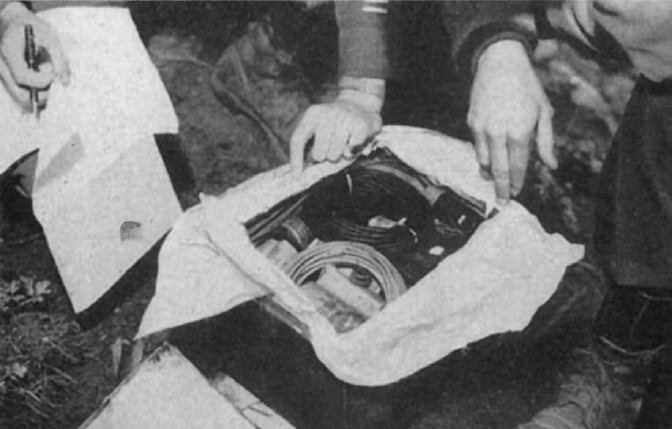
Unlike the American Office of Strategic Services (OSS) and British Special Operations Executive (SOE), which generated a seemingly endless array of ingenious sabotage devices, the Germans mainly used standard explosive and incendiary devices and even captured Allied munitions (see opposite). Many of the previously discussed booby traps were used for sabotage purposes. The following are, again, extracts from contemporary Allied publications.
The Germans have been ruthless in destroying key installations and facilities in the course of their withdrawals and may be expected to lay continued emphasis on this practice at they retreat further into the Fatherland. At the same time the Germans probably will continue to attempt as much sabotage behind Allied lines as may be possible within their resources. Conveniently arranged enemy sabotage kits have been found hidden near important installations in France. They were probably earmarked for destruction when opportunities arise. These kits included standard German demolition items, special-purpose sabotage devices, and captured British munitions.
The kits found in Germany consisted of two large can-like containers packed in a rectangular metal box about 9in x 24in x 24in. There were at least eight different types of kits containing different combinations of hand grenades, prepared explosive and incendiary charges, detcord, safety fuse, delay time pencils, friction igniters, blasting caps, adhesive tape, Vaseline tubes for waterproofing, abrasive Vaseline for sabotage, railroad fog signals to rig as detonators, etc. These German sabotage efforts were mainly aimed at transportation capabilities: seaports, rail yards, airfields, and road traffic. They seemed to place a great deal of reliance in incendiary devices and firing fuel supplies. After VE-Day there were few sabotage attacks and the much-anticipated “Werewolves” never emerged from their dens.
German plans to have a ring of German-trained Italian saboteurs operate in Rome after the city had been occupied by Allied troops collapsed when the ring was uncovered and buried sabotage materials located.

Another recovered German container of sabotage gear, including safety time fuse and detcord. The metal containers used for this purpose were well waterproofed.
The ring, left by the retreating Germans under the direction of an Italian leader amply supplied with money and jewelry, was composed of both men and women. Before the Germans quit the city, explosives, detonators, and sabotage devices were packed in large cans and buried. They were to be dug up as needed.
All of the ring’s members had been trained in a German four-week course. It covered explosives, both plastic and solid; incendiaries, bombs of various types, instructions in placing explosives to ensure maximum damage and time for escape without detection, methods of eluding Allied troops and investigators, driving, repair, and sabotage of both automobiles and motorcycles, pistol, rifle, and submachine gun firing, and gymnastics.
The Germans, however, wasted this training on poor underground prospects. This particular group of Italians showed no eagerness to carry out the missions assigned by their retreating German masters, although there was ample time to do so. All were arrested. More determination to carry out sabotage orders may be expected from the Germans themselves – in their own country. They may also employ devices similar to those left in Rome. The variety of sabotage devices, of course – like the variety of booby traps – is as wide as human ingenuity. Hidden throughout Rome were numerous approximately 3-gallon cans containing incendiary and explosive charges, time fuse, detcord, time delay pencils, and fake lumps of coal containing an explosive change.
Various techniques alleged to be used by German “fifth columnists” were reported through the war. For the most part there was no need for specialized gear:
1. Placing open cans of gasoline under parked trucks and attaching slow fuses to ignite the fuel.
2. Mixing sand with grease in the journal-box of freight cars to create “hot boxes” by friction in the axle mechanism.
3. Removing the sleeper plates and bolts fastening railroad rails together.
4. Laying charges under rails to explode when the locomotive passes over (detonated by fog signals).
5. Sabotaging a large quality of gasoline by adding soap flakes.
6. Placing abrasives (probably sand or sugar) in vehicle gas tanks to plug fuel lines or block carburetors.
7. Cutting truck spark plug wires and other wiring.
8. Short-circuiting electric power lines by throwing ropes over two or more lines and pulling them together.
9. Cutting and removing lengthy sections of telephone and telegraph lines.
10. Port workers cutting straps on life jackets aboard merchant ships.